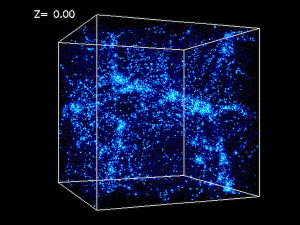Post
Ever Expanding,
Into Nothing
12 February 2012
 HST, ACS, WFC, H. Ford (JHU)
HST, ACS, WFC, H. Ford (JHU)One of the most common questions I get asked as an astrophysicist is “What is the universe expanding into?” To answer this question I’m going to build upon an earlier post about how the universe can be both closed and flat. If you haven’t read it, go read it. I’ll wait.
Welcome back! As you now know from the previous post we saw how we could “connect” the edges of a sheet of paper to make a “paper space” that is both flat and closed. This time we’re going to do the same with real space.
Imagine you have a cubic box. This box contains a certain volume, which is just the cube of the length of one side. A regular box is bounded on all sides by the walls of the box, just as our sheet of paper was bounded on all sides by the edges of the paper. And just like our sheet of paper, we can get rid of our boundaries in two ways. One way is to make the dimensions of our box infinite. If we put a little atom in our infinite box (we’ll ignore gravity for now), it would just travel on forever without hitting a side, since the sides are infinitely far away.
The other way to get rid of the boundaries is to “connect” the sides of our box with our connection rule from last time: When you get to a side of the box, move to the opposite side of the box and keep going. In this way we can connect the top of the box to bottom, the left side to the right, and the front to the back. So now if our little atom is travelling off to the right, when it reaches the right side of the box it finds itself at the left side of the box, and keeps moving to the right, eventually ending up where it started.
There are a couple of things to note about our connected box. The first is that our connected box doesn’t have any sides. It doesn’t need them. By connecting the sides we’ve eliminated the need for physical boundaries. We don’t need to contain the volume with boundaries, because our connected volume contains itself. Our connection rules mean that our space is its own container. This is really hard to visualize, but it means that our connected box is a finite volume with no boundaries. There is no “edge” to our space.
It is a bit easier to understand if we look at things from our little atom’s point of view. We know that our travelling atom is looping round and round our space, but from the atom’s perspective it is moving forever in a straight line. Our connected space is still “flat”, and parallel lines don’t cross. Without any boundaries, and without any landmarks to show where the atom has been, our connected space looks exactly like infinite space to our atomic traveller.
The difference is that our connected space has a finite volume. The volume is exactly that of a regular box, just the cube of the length of one side. If we change the length of the side we can make the volume as large or as small as we like. But for a single atom (as long as the box is not too small), it will still look just like infinite, flat space.
So now let’s fill our box with lots of atoms, so that our connected space is filled with a gas of atoms. In a regular box, a contained gas has a particular temperature and pressure. Compress the box and the temperature and pressure will go up, expand the box and the temperature and pressure will go down. The same is true for our connected space. Make the volume smaller, pressure and temperature go up. Make the volume bigger and they go down.
Suppose then that we slowly increase the volume of our connected space. What would it look like to the atoms of the gas? Since the volume is increasing, the density of the gas is decreasing. This means that the average distance between the atoms is increasing. If our little atom is very observant, it would notice that the average distance of nearby atoms is increasing, but the average distance of more distant atoms is increasing more quickly. The more distant an atom is from it, the more quickly its distance is increasing.
This is exactly what we see in our universe. Nearby galaxies typically move away from us slowly. Distant galaxies move away from us quickly. The more distant the galaxy is from us, the faster it typically moves away.
 University of Chicago
University of ChicagoSo back to our question. If you were to ask our little atom what its universe is expanding into, how could the atom respond? From its perspective space looks infinite. It has always looked infinite. Our little atom could always travel in a straight line forever without ever reaching the end of space. We know that it’s trapped in a loop, but it doesn’t appear that way to the atom. And since the connected space contains itself, there really is no boundary to the space. Finite volume, but no container.
What would be apparent is that the connected space is increasing in volume. The atoms know this because the distances between atoms is increasing, and distant atoms appear to be receding faster than close ones. Their universe is expanding, without expanding into anything.
Just like our universe.